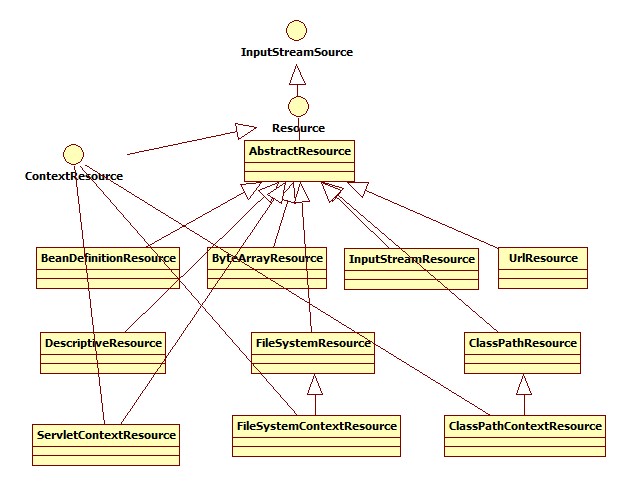在Java中,将不同来源的资源抽象成URL,通过注册不同的handler(URLStreamHandler)来处理不同来源的资源的读取逻辑,一般handler的类型使用不同前缀(协议,protocol)来识别,如“file:”、“http:”、“jar:”等,然而URL没有默认定义相对classpath或ServletContext等资源的handler,虽然可以注册自己的URLStreamHandler来解析特定的URL前缀(协议),比如“classpath:”,然而这需要了解URL的实现机制,而且URL也没有提供一些基本的方法,如检查当前资源是否存在、检查当前资源是否可读等方法。因而Spring对其内部使用到的资源实现了自己的抽象结构:Resource接口来封装底层资源:
public interface InputStreamSource {
InputStream getInputStream() throws IOException;
}
public interface Resource extends InputStreamSource {
boolean exists();
boolean isReadable();
boolean isOpen();
URL getURL() throws IOException;
URI getURI() throws IOException;
File getFile() throws IOException;
long lastModified() throws IOException;
Resource createRelative(String relativePath) throws IOException;
String getFilename();
String getDescription();
}
InputStreamSource封装任何能返回InputStream的类,比如File、classpath下的资源、Byte Array等。它只有一个方法定义:getInputStream(),该方法返回一个新的InputStream对象。
Resource接口抽象了所有Spring内部使用到的底层资源:File、URL、classpath等。首先,它定义了三个判断当前资源状态的方法:存在性(exists)、可读性(isReadable)、是否处于打开状态(isOpen)。在C语言中,当我们拿到一个文件句柄时,我们要调用open方法打开文件才可以真正读取该文件,但是在Java中并没有显示的定义open方法,一般当我们创建一个InputStream、Reader时,该资源(文件)就已经处于打开状态了,因而这里的isOpen方法并不是判断当前资源是否已经处于打开的可操作状态,这里是表示Resource接口所抽象的底层资源是否可以多次调用getInputStream()方法,如果该方法返回true,则不可以多次调用getInputStream()方法。在Spring 2.5.6的实现中,只有InputStreamResource类的isOpen()方法返回true,其余都返回false。
另外,Resource接口还提供了不同资源到URL、URI、File类型的转换,以及获取lastModified属性、文件名(不带路径信息的文件名,getFilename())的方法。为了便于操作,Resource还提供了基于当前资源创建一个相对资源的方法:createRelative();在错误处理中需要详细的打印出错的资源文件,因而Resource还提供了getDescription()方法用于在错误处理中的打印信息。
在Spring 2.5.6中,所有实现Resource的接口类继承关系图如下:

即对不同来源的资源文件都有相应的Resource实现:文件(FileSystemResource)、classpath资源(ClassPathResource)、URL资源(UrlResource)、InputStream资源(InputStreamResource)、Byte数组(ByteArrayResource)等。
AbstractResource类
AbstractResource是对Resource的基本实现,所有Resource实现类都继承了该类,所有继承该类的Resource一般只需要实现以下方法即可:
public File getFile() throws IOException
public URL getURL() throws IOException
public String getDescription()
public InputStream getInputStream() throws IOException
该类默认实现中,将toString、equals、hashCode都代理给Description属性;isReadable总是返回true,而isOpen总是返回false;exists方法实现中,先调用getFile返回的File对象的exists方法,如果失败,查看是否可以获得InputStream,如果可以,返回true,否则,返回false;getURL和getFile、createRelative方法抛出FileNotFoundException,而getURI则代理给getURL方法。
ByteArrayResource类
ByteArrayResource是一个简单的Resource实现,它是对二进制数组的封装,每次调用getInputStream时都会以这个二进制数组作为源创建一个ByteArrayInputStream。它的exists方法总是返回true,而且重写了equals、hashCode的方法,以判断二进制数组的内容;它的description属性可以是用户自定义,也可以使用默认值:resource loaded from byte array
public final byte[] getByteArray() {
return this.byteArray;
}
public boolean exists() {
return true;
}
public InputStream getInputStream() throws IOException {
return new ByteArrayInputStream(this.byteArray);
}
FileSystemResource类
FileSystemResource是对File的封装,在构建FileSystemResource时可以传入File对象或路径字符串(这里的路径可以是相对路径,相对路径是相对于System.getProperty(“user.dir”)的值所在的路径,也可以是绝对路径,也可以是“file:”开头的路径值),在内部会创建相应的File对象,并且计算其path值,这里的path是计算完“.”和“..”影响的值(规格化)。
在getInputStream方法中,使用该File对象创建FileInputStream;而path值作为description属性、equals、hashCode等方法的实现;所有其他方法(exists、isReadable、getURL等)都代理给File对象;createRelative方法中使用path计算相对路径,其算法是:找到最后一个路径分隔符(/),将相对路径添加到该分隔符之后,传入的相对路径可以是以路径分割符(/)开头,也可以不以分隔符(/)开头,他们的效果是一样的,对相对路径存在的“.”和“..”会在创建FileSystemResource类时处理。最后,当使用将一个目录的File对象构建FileSystemResource时,调用createRelative方法,其相对路径的父目录和当前FileSystemResource的父目录相同,比如使用”/home/Levin/dir1”目录创建FileSystemResource对象,该Resource对象调用createRelative,并传入”file”,那么出现的结果为”/home/Levin/file”,如果要得到”/home/Levin/dir1/file”,那么构建FileSystemResource时,应该传入”/home/Levin/dir1/”字符串。
public boolean isReadable() {
return (this.file.canRead() && !this.file.isDirectory());
}
public InputStream getInputStream() throws IOException {
return new FileInputStream(this.file);
}
public Resource createRelative(String relativePath) {
String pathToUse = StringUtils.applyRelativePath(this.path, relativePath);
return new FileSystemResource(pathToUse);
}
public String getDescription() {
return "file [" + this.file.getAbsolutePath() + "]";
}
UrlResource类
UrlResource是对URL和URI的封装。在构建UrlResource时可以传入URL、URI和Path字符串(带协议字符串,如”file:”)。在UrlResource内部还会创建一个cleanedUrl,它是规格化(计算“.”和“..”后的值),该URL将会用于equals、hashCode方法的实现。
在getInputStream方法实现中,它使用URL.openConnection()方法获取URLConnection,后调用该URLConnection的getInputStream方法。对getFile()方法,只支持文件系统的资源,即URL字符串的协议部分为”file:”。UrlResource还支持从jar、zip、vfszip、wsjar等内部文件,以jar为例,这些文件的字符串表达为:jar:file:/<jarpath>/jarfile.jar!/<filepath>/filename,如jar:file:/E:/Program%20Files/eclipse-juno/plugins/org.junit_4.10.0.v4_10_0_v20120426-0900/junit.jar!/org/junit/Test.class,然而这些内部文件本身并没有lastModified的属性,因而对这些内部文件,UrlResource将jar、zip等文件的lastModified视为这些内部文件的lastModified属性。对createRelative方法,直接使用URL提供的构造函数,忽略传入的relativePath中的路径分隔符“/”。
public InputStream getInputStream() throws IOException {
URLConnection con = this.url.openConnection();
con.setUseCaches(false);
return con.getInputStream();
}
protected File getFileForLastModifiedCheck() throws IOException {
if (ResourceUtils.isJarURL(this.url)) {
URL actualUrl = ResourceUtils.extractJarFileURL(this.url);
return ResourceUtils.getFile(actualUrl);
}
else {
return getFile();
}
}
public Resource createRelative(String relativePath) throws MalformedURLException {
if (relativePath.startsWith("/")) {
relativePath = relativePath.substring(1);
}
return new UrlResource(new URL(this.url, relativePath));
}
ClassPathResource类
对classpath下资源的封装,或者说是对ClassLoader.getResource()方法或Class.getResource()方法的封装。它支持在当前classpath中读取资源文件。可以传入相对classpath的文件全路径名和ClassLoader构建ClassPathResource,或忽略ClassLoader采用默认ClassLoader(即Thread Context ClassLoader),此时在getInputStream()方法实现时时会使用ClassLoader.getResourceAsStream()方法,由于使用ClassLoader获取资源时默认相对于classpath的根目录,因而构造函数会忽略开头的“/”字符。ClassPathResource还可以使用文件路径和Class作为参数构建,此时若文件路径以“/”开头,表示该文件为相对于classpath的绝对路径,否则为相对Class实例的相对路径,在getInputStream()方法实现时使用Class.getResourceAsStream()方法。
getFile()方法只支持存在于文件系统中的资源;对lastModified的属性,若是jar、zip等文件中的资源,则采用jar、zip文件本身的lastModified属性;equals会同时判断path、classloader、clazz字段,而hashCode则只使用path。
public InputStream getInputStream() throws IOException {
InputStream is = null;
if (this.clazz != null) {
is = this.clazz.getResourceAsStream(this.path);
}
else {
is = this.classLoader.getResourceAsStream(this.path);
}
if (is == null) {
throw new FileNotFoundException(
getDescription() + " cannot be opened because it does not exist");
}
return is;
}
public URL getURL() throws IOException {
URL url = null;
if (this.clazz != null) {
url = this.clazz.getResource(this.path);
}
else {
url = this.classLoader.getResource(this.path);
}
if (url == null) {
throw new FileNotFoundException(
getDescription() + " cannot be resolved to URL because it does not exist");
}
return url;
}
public File getFile() throws IOException {
return ResourceUtils.getFile(getURL(), getDescription());
}
protected File getFileForLastModifiedCheck() throws IOException {
URL url = getURL();
if (ResourceUtils.isJarURL(url)) {
URL actualUrl = ResourceUtils.extractJarFileURL(url);
return ResourceUtils.getFile(actualUrl);
}
else {
return ResourceUtils.getFile(url, getDescription());
}
}
public Resource createRelative(String relativePath) {
String pathToUse = StringUtils.applyRelativePath(this.path, relativePath);
return new ClassPathResource(pathToUse, this.classLoader, this.clazz);
}
InputStreamResource类
InputStreamResource是对InputStream的封装,它接收InputStream作为构造函数参数,它的isOpen总是返回true,并且只能被读取一次(即getInputStream方法只能被调用一次),exists、isReadable方法也总是返回true。由于它不能被多次读取,只有当不用多次读取的时候才使用该类,并且只有当没有其他可用Resource类时才使用该类。在Spring内部貌似没有使用它。它只实现了getInputStream方法:
public InputStream getInputStream() throws IOException, IllegalStateException {
if (this.read) {
throw new IllegalStateException("InputStream has already been read - " +
"do not use InputStreamResource if a stream needs to be read multiple times");
}
this.read = true;
return this.inputStream;
}
DescriptiveResource类
DescriptiveResource是对非物理资源的Description的封装。它实现了getDescription()方法。Resource中Description属性主要用于错误处理时能更加准确的打印出错位置的信息,DescriptiveResource提供对那些需要提供Resource接口中的Description属性作为错误打印信息的方法自定义的描述信息。比如在BeanDefinitionReader中,在仅仅使用InputSource作为源加载BeanDefinition时,就可以使用DescriptiveResource定义自己的Description,从而在出错信息中可以方便的知道问题源在哪里。
BeanDefinitionResource类
在Spring中Resource可以用于非物理资源的抽,BeanDefinitionResource是对BeanDefinition的封装。BeanDefinitionResource类似DescriptiveResource,它也只实现了getDescription()方法,用于在解析某个BeanDefinition出错时显示错误源信息:
public String getDescription() {
return "BeanDefinition defined in " + this.beanDefinition.getResourceDescription();
}
ContextResource接口
在Spring中还定义了ContextResource接口,继承自Resource接口,只包含一个方法:
public interface ContextResource extends Resource {
String getPathWithinContext();
}
getPathWithContext()方法相对于Context的路径,如ServletContext、PortletContext、classpath、FileSystem等,在Spring core中它有两个实现类FileSystemContextResource、ClassPathContextResource,他们分别是FileSystemResourceLoader和DefaultResourceLoader中的内部类,他们对getPathWithContext()方法的实现只是简单的返回path值。
另外,在Spring Web模块中,有一个ServletContextResource实现类,它使用ServletContext和path作为参数构造,getInputStream、getURL、getURI、getFile等方法中将实现代理给ServletContext,其中getPathWithContext方法依然返回path字符串:
public boolean exists() {
try {
URL url = this.servletContext.getResource(this.path);
return (url != null);
}
catch (MalformedURLException ex) {
return false;
}
}
public InputStream getInputStream() throws IOException {
InputStream is = this.servletContext.getResourceAsStream(this.path);
if (is == null) {
throw new FileNotFoundException("Could not open " + getDescription());
}
return is;
}
public URL getURL() throws IOException {
URL url = this.servletContext.getResource(this.path);
if (url == null) {
throw new FileNotFoundException(
getDescription() + " cannot be resolved to URL because it does not exist");
}
return url;
}
public File getFile() throws IOException {
String realPath = WebUtils.getRealPath(this.servletContext, this.path);
return new File(realPath);
}
public Resource createRelative(String relativePath) {
String pathToUse = StringUtils.applyRelativePath(this.path, relativePath);
return new ServletContextResource(this.servletContext, pathToUse);
}